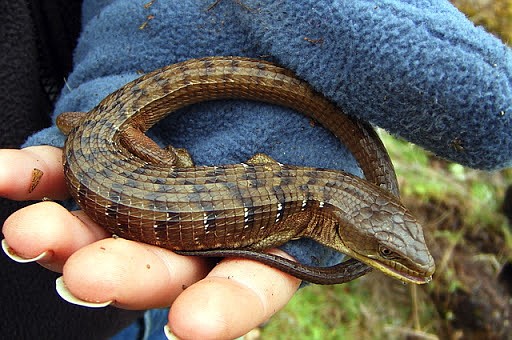Alligator lizard continues to adapt, thrive
Despite its common name, Elgaria coerulea is of no relation to the alligator. This reptile is a member of the Anguidae family, a diverse group of lizards common throughout North and South America, Europe, Asia and Africa. The northern alligator lizard itself only exists along the forests, woodlands and grasslands of the western coast of North America, from California, through Oregon, and Washington, as far east as northern Idaho and Montana, and as far north as southern Canada. This genus is one of only five lizard species native to Canada.
The northern alligator lizard grows to more than 10 inches long — and nearly 7 inches of that is its long tail. If you want to find them in their natural habitat, look under the logs, rocks and tree bark of the dryer parts of forested hilly or mountainous areas. How do you know you’ve found a northern alligator lizard?
Observe its coloration. These lizards typically vary from brown, gray or olive on their upper regions and have a brown or olive-gray band running down the middle of the back. The underbelly is gray. Some individuals have dark-colored spots as well.
Since this creature is a reptile, you probably thought it reproduced by laying eggs. But the northern alligator lizard is actually viviparous, which means it gives birth to live young, as mammals do. Baby northern alligator lizards are tiny creatures, no more than 4 inches long, and they’re born in late summer and early fall. Unlike mammals, the lizards exhibit no parental care once the eggs hatch. The baby lizards are on their own from day one. As they grow, they learn how to catch their preferred prey, usually crickets, mealworms, snails, slugs, spiders, moths, bird eggs, smaller lizards and even baby mice and birds.
Sometimes the northern alligator lizard is prey instead of predator. A number of larger carnivorous mammals and birds find these reptiles delicious. To escape, the lizards often try to bite the predator or emit a stinky brew of waste and musk. As a last resort, they have the ability to shed their tails. Once separated, the tail wiggles as if it were its own living creature. This usually distracts the predator long enough for the lizard to make a quick getaway. Fortunately, the tail will soon regenerate in case the animal has another brush with death.
Unlike many animals we discuss, the northern alligator lizard is doing well in the wild. They adapt to changes in their environments, such as mild habitat destruction, and can even be found resting under trash and other man-made surface covers in populated areas where logs, rocks and bark are hard to come by.
These lizards make great pets. If you consider adopting a northern alligator lizard into your family, be sure not to collect one from the wild. Wild-caught reptiles sometimes carry diseases and parasites, and they often find it hard to adjust to living in enclosed spaces and in close proximity to people. Try your local pet store instead.
- • •
The writer may be reached at animaladventures1314@gmail.com.



